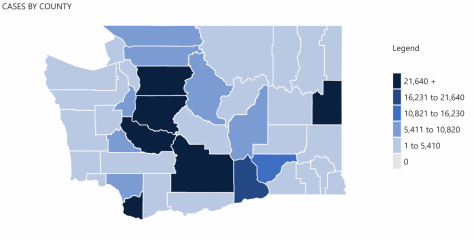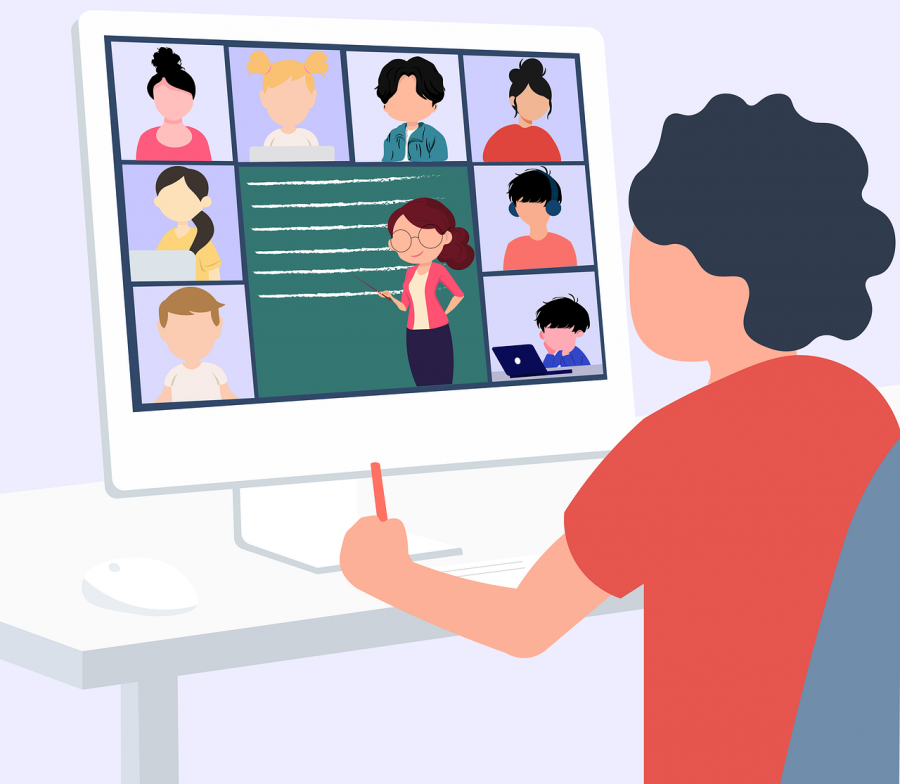Staying 100% Online
On Friday, March 12th, 2021, Gov. Jay Inslee instructed districts to offer at least some in-person instruction to all students by the following month. On April 19th, Northshore reopened its doors to middle and high school students. During the time between the two announcements, students were frantically sharing news posts and media threads, desperately trying to piece together information and gather some insight on the announcement. Polls were popping up on Instagram to calculate who was going back to school and who was choosing to stay home— and most were split almost fifty percent!
As of May 19th, according to the Washington State Department of Health, there have been almost 103.2k new confirmed cases in King County, and almost 36k in Snohomish. Granted, vaccination rates have also been increasing due to wider eligibility, but acquiring one is no easy feat either.

Now that kids are back in buildings and classrooms, it poses the question: will this bring more harm or more good? While a lot of kids reported on a survey that they were glad to go back and see friends and have some long-lost normalcy, most had negative thoughts about returning, worried about health precautions, schedule disruptions, and learning inefficiencies.
“Evidently, the hybrid model has some flukes,” comments Joseph Riggio (‘22). “While getting students back into the classroom should be a priority, so is doing it safely and effectively. [Even] many of my teachers have expressed some level of confusion regarding the hybrid learning system’s logistics.”
Now it’s no secret that some Washingtonian parents were pushing for schools to reopen, but when Inslee made the official announcement, both his Twitter & Instagram accounts blew up with hundreds of comments from angry parents and administrators. The Governor’s official Tweet stated “The impact of this pandemic on our children’s mental health has created a crisis among our young people. Now is the time for all schools to return to the classroom,” which led to many additional comments rebuking Inslee’s mental health incentive, saying that “reopening schools won’t fix the problem,” and that students “need real counsellors and specialists, not school.”
The real truth is that school affects students’ mental health even when the country isn’t in a global pandemic. Particularly during Covid times, it’s important that kids are allowed to follow a schedule, and online learning – while still tough and with its own flaws – has provided that routine.
“Even if you don’t typically thrive on a strict schedule, having a routine can be helpful in times of unpredictability, uncertainty, and stress,” writes Kendra Cherry of VerywellMind. “Implementing a structure to your day can give you a sense of control. It can also improve your focus, organization, and productivity.” Especially in young kids, it’s important to remember that children tend to look to adults for guidance during stressful times. When we teach them how to follow a routine and how to adjust and problem solve, it can help reduce anxiety through predictability.
“After a week of hybrid, I still feel that staying online is the best decision for me,” agrees Gracie Hemmat (‘22). “I personally work well online [and] by now, I’ve figured out how to learn remotely.”
After almost thirteen months of online schooling, most students are feeling comfortable with classroom and curriculum setups. Several kids report that online classes are easier, less stressful, and more flexible. They even note that the teachers are adjusting to the new system policies and technology changes. It’s still not ideal for everyone, but it quickly became the new normal. To disrupt the flow now is just going to make it unnecessarily harder and could easily end up being counterproductive – a large contrast to the expectations people seem to have of reopening schools.
“It seems unbeneficial to try a completely new style of learning 2 months before school gets out,” Riggio adds. “I’d rather wait until Fall. From what I’ve witnessed, classrooms are now chaotic and disproportionate throughout the week, not to mention the accidental teacher neglect on both ends – especially towards the minority of [whichever group]. I’d rather be comfortably working at home than trying to do my schoolwork in an environment of chaos.”
Another student writes, “I [like to] work in my own environment that I have maintained a mostly stable atmosphere in,” the surveyee says. “ I have no fears over Covid and remain in a rather safe situation. While I would like to be in person with a lot of my friends, the risk and pains I would go through to do that would be far too great.”
Since March 22nd (and updated May 19th,) there have been 144 new confirmed cases in the district between staff and students of all groups, and 899 in quarantine, according to Northshore’s Covid19 Dashboard. Northshore is taking extra precautions for those returning for hybrid learning, including batch testing twice a week and class testing each 1st period. There are also daily health checks, parental confirmations, and social distancing protocols campus and classroom-wide.
Per the state mandate, districts were required to hold a form of in-person schooling. Plans were rushed, impromptu policies were made, and now staff and students are back in the buildings. Schedules and guidelines fluxed while both teachers and students scrambled to get a grasp of yet another new incoming reality. For those needing to go back for whatever reason (childcare, focused learning, etc) or those just needing a change and willing to take the risk, “it’s great that it’s an option,” Gracie states. But just maybe not the safest one. Not everybody has the opportunity to go back to in-person schooling. Some families have increased health risks or other safety-adjacent bases to stay home.
“It honestly kind of sucks,” one student admits. “It’s hard to watch other people go back in person when I don’t even get the choice,”
Safety should be the number one priority, and although our district is doing everything they can to keep staff and students healthy and safe in order to return to school, it’s important to remember that times like these are still unpredictable; just because we can, doesn’t mean we should. Radio and Tv stations keep commenting on Covid spikes, prompting rumor circulations about phase adjustments and new stay-at-home protocols. We’ve been in quarantine for nearly fifteen months now and most of us are already accustomed to online life and all sorts of multimedia platforms. Why change everything now and increase the risks?








wendy wands • May 24, 2021 at 1:17 pm
As much as I do enjoy the connections by being back at school, I agree that it was a rushed pressured decision made by the Gov. to start in April with such a short time left in school. Having to learn yet another set of educational policies also have thrown many to the curb. My daughter who teaches in a Seattle HS had 100% attendance while online, after the 19th, she had a huge drop as many of her kids have to work to help their own families. Again, I do like being at school, but would have rather have waiting until the fall where it seemed to me there would have been more planning.
I also am concerned that we may have another outbreak, with those not vaccinated and not masking and being in groups…I am a super positive person, but there are days when i read the newspaper and think “we are doomed” to be with covid forever.
Thanks for this great opinion piece!